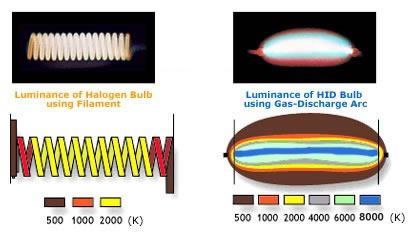0 Item(s) ~ £0.00
HID Xenon Technical Details
What is HID Xenon?
High Intensity Discharge (HID) is a new type of lighting technology that's primarily different from the conventional halogen bulbs that use a heated tungsten filament. Unlike Halogen lamps, High-Intensity-Discharge (HID) lamps don't have a filament but create light by the arc between two electrodes. The xenon gas allows the lamps to produce minimally adequate amounts of light immediately upon startup and speed the warmup time. The arc vaporises the metal halide which produces light as the temperature and pressure increases.
The xenon gas allows the lamps to produce minimally adequate amounts of light immediately upon startup and speed the warmup time. The arc vaporises the metal halide which produces light as the temperature and pressure increases.
The light produced by an HID Xenon lighting system is greater than a standard halogen bulb and with less power consumption. On the road, HID Xenon lighting systems appear as a bright white beam which resembles natural daylight. The bright white beam offers greater visibility and road safety.
In an HID Xenon lighting system, the voltage between the two electrodes rises firstly from 12V to 23000V and keeps stable at 8000V by using the Xenon HID ballasts system. Due to the ultra high voltage, the Xenon gas ionises and a super-bright beam is produced, whose colour temperature is up to 12000K. The HID Xenon lighting is much more economic, more stable and brighter than conventional vehicle lighting.
The Advantages of Xenon Light
Low Power Consumption
The xenon bulb provides more than twice the amount of light of a halogen bulb, while only consuming half the power (wattage). Therefore, the driver can see more clearly, and the car has more power for other functions. Moreover, it is environmentally friendly, as less power means less fuel consumption.
Three Times Brighter
The clear white light produced by the Xenon bulb is similar to daylight. Research has shown that this enables drivers to concentrate better. Furthermore, this particular light colour reflects the road markings and signs better than conventional lighting.
Extremely Long Life
The xenon bulb also delivers a marked contribution to road safety in the event of limited visibility due to weather conditions. In practical terms, the life span of the bulb is equal to that of the car, which means that the bulb need only be replaced in exceptional cases.
Chromaticity and Colour Temperature
Colour Temperature is a measurement in Degrees Kelvin that indicates the hue of a specific type of light source. Many people believe the misconception that colour temperature is a rating of the brightness of the bulb or HID kit. This belief is completely false. The reality of the matter is that the higher the colour temperature, the less useable light output you will obtain.Higher K kits such as 8000k, 10000k, etc. have been manufactured for individuals that are more concerned about the actual colour output of their lights as opposed to the actual usable light output they produce.
 The CIE 1931 x,y chromaticity space, also showing the chromaticities of black-body light sources of various temperatures, and lines of constant correlated color temperature. This diagram illustrates how the colour of the light emitted will change as the colour temperature (K) changes.
The CIE 1931 x,y chromaticity space, also showing the chromaticities of black-body light sources of various temperatures, and lines of constant correlated color temperature. This diagram illustrates how the colour of the light emitted will change as the colour temperature (K) changes.
To the right is a diagram illustrating the increase in field of vision and the typical K ratings of related products.
Glare and Reflector type Headlights
One of the dangers of buying and installing a cheap aftermarket HID conversion kit with bad bulbs into a normal reflector headlight is blinding other road users, usually referred to as 'glare'.HIDS4U was one of the first to sell HID Conversion kits in the UK and the only one that actually understands how they work. We have developed specific solutions to overcome glare, bulb alarms and other canbus issues.
On many vehicles that use reflector type headlights, badly designed bulbs can cause light to spread in too wide a pattern. On normal halogen bulbs, this is not a major problem, but when HID headlight bulbs with three times the power are installed, it can cause unwelcome glare. To counteract this we developed a range of bulbs especially for this type of headlight. The bulbs are designated with an 'R', such as the H7R bulbs, and are available in the sizes most commonly used by reflector headlights.
 These bulbs are designed by HIDS4U and made exclusively by a manufacturer in Korea. The bulbs have an extensive coating, which is carefully designed to block any glare. They work in a similar way to OEM HID reflector headlights which use shields built into the headlight unit.
These bulbs are designed by HIDS4U and made exclusively by a manufacturer in Korea. The bulbs have an extensive coating, which is carefully designed to block any glare. They work in a similar way to OEM HID reflector headlights which use shields built into the headlight unit.
The improved bulbs increase safety by putting the light on the road, and not directing it towards oncoming traffic.

